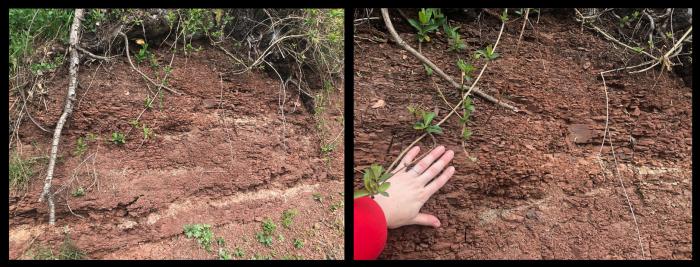Overview
As technology advances, the way in which geologists study the Earth also advances. Some of these new technologies also make it possible to bring aspects of the field into the classroom. This opens up opportunities for broader audiences to explore a wider range of geologic structures and localities. Structure from motion (SfM) is one of these technologies that is enabling scientists and classrooms to examine a variety of locations that might otherwise be difficult to study due to travel constraints, remoteness, or inaccessibility. SfM is a computer program that uses an algorithm to create a 3D structure from a series of 2D images, and the application of this program in the geosciences can allow scientists and students alike to approach geology in a whole new way.
Objectives
This activity was developed by PolarTREC educator, Dr. Lauren Neitzke Adamo, as a collaboration between PolarTREC, the Geological Society of America, and the American Geosciences Institute for use in the Annual Earth Science Week toolkit.
The theme for the 2019 Earth Science Week (October 13-19, 2019) is "Earth Science is for everyone", so this lesson plan focuses on how cutting edge geological tools and methods can be incorporated into classrooms to make geology more accessible for all audiences. This could be used in many different classes but is most appropriate for grades 6 to 12.

Procedure
Break into small groups and with your teacher’s help, choose a nearby outcrop or landscape to create a 3D image of. Each group should use a different area or section of one outcrop/landscape.
The program will calculate the shape of the target area, but not the size. Before taking the pictures, measure the size of the target area or place markers within the area at a known, measured distance that can be used for scale in the photographs.
Using a digital camera, take a series of photographs of the target area from many different angles.
As a group, make a list of observations about the geology, shape, etc. of the target area.
Return to the classroom and import the photographs onto a computer without altering them.
Your teacher will have already installed the program and will help walk you through the steps to create the 3D image (i.e., aligning photographs, creating a dense point cloud, and creating a mesh). This process can take minutes to days depending on the settings, file size, etc.
Examine the resulting 3D image and discuss how accurately the target area was rendered. Think about how you might improve the overall accuracy of the image.
Repeat these steps until the 3D image is as accurate as possible.
Make a list of observations of the target area based solely on the 3D image. Compare this with the list of observations made in the field.
Exchange images with another group and make a list of observations about their image.
Compare observations with the other group and discuss any details that were missing from the 3D images but observable in the field.
Discuss with the entire class and your teacher how this technology could help expose a wider audience to the geosciences that might normally face barriers to conducting fieldwork.
Visit the Agisoft Metashape website for information on the SfM software and to download an Educators' version of the program.
Instructions for this software can be found under the "Download and Using the SfM Software" section on another PolarTREC lesson
An open-source version of this software can be downloaded on the Regard3D website
Extension
This lesson could be expanded to have students repeat these procedures to produce 3D models at several different locations so they could compare the results and/or landforms at different sites. Alternatively, the lesson could be completed at different times of the year so that students could observe and track the changes to the landforms over a period of time. This could lead to discussions on the climate and weather, and weathering and erosion of landforms.
Transferability
This lesson is written from a geology perspective, but this method can be used in a number of different fields such as biology, historic preservation, anthropology, land use planning and development, ecology, and many more. Science teachers could work with teachers in other fields to help develop a project that would use these methods to address a non-science related issue.
Resources
The procedures in this activity go over some methods used in the field of remote sensing and geodesy. Both are evolving fields that use innovative technology to study and measure the Earth. Scientists can learn lots of information by studying the exact shape of the Earth and how it changes over time. These changes can be used, like they were in the “Sliding Glaciers” project, to study climate change, but there are many other applications.
The following are just a few of the additional resources and geodesy/remote sensing lesson plans currently available online.
Assessment
No formal assessment was created for the assignment, however, educators can create their own assessment to meet the needs of their classroom. Students could be asked to create a laboratory report to details the procedures, observations, conclusions, etc.
Author/Credits
Dr. Lauren Neitzke Adamo 2018 PolarTREC Educator Director, Rutgers Geology Museum
This lesson was developed with the help of Dr. Lucas Zoet at the University of Wisconsin, Madison and Dr. Neal Iverson at Iowa State University.
Standards Other
Next Generation Science Standards (NGSS)
Science and Engineering Practices
Developing and Using Models
Analyzing and Interpreting Data
Planning and Carrying Out Investigations
Crosscutting Concept
Scale Proportion and Quantity
Systems and System Models
Interdependence of Science, Engineering, and Technology
Disciplinary Core Idea
Earth’s Systems or Earth’s Place in the Universe
Information Technologies and Instrumentation
| Attachment | Size |
|---|---|
| Download Lesson Plan (PDF - 5 MB)4.42 MB | 4.42 MB |
This program is supported by the National Science Foundation. Any opinions, findings, and conclusions or recommendations expressed by this program are those of the PIs and coordinating team, and do not necessarily reflect the views of the National Science Foundation.
